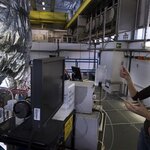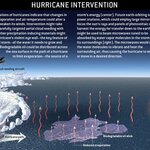Atmospheric

One evening last spring, Peter nearly stopped breathing.
He was riding in the car with his mother, April, who was taking the 11-year-old boy back from a visit to the ER for one of his chronic asthma attacks. He seemed to be getting better — and then his throat began to constrict. He began to wheeze loudly. He rolled his head back to get more air.
"That was wrong. 'He should be better than this by now,' I remember thinking. I knew something was wrong then," April recalls. "They had given him some meds and the usual advice, but it was not working."
She turned the car around and drove her son…

What did Greenland look like over the last 800,000 years? Hard to know for sure but one thing is certain; it changed often, and quickly.
Drill cores taken from Greenland's vast ice sheets show that Earth's climate is capable of very rapid transitions - more of a mystery is why abrupt climate changes like that happen.
Layers of ancient snow accumulated and became compact to form the ice-sheets we see today. Each layer of ice can reveal past temperatures and even evidence for the timing and magnitude of distant storms or volcanic eruptions. By drilling cores in the ice scientists have…

Clouds amplify climate change, says Texas A&M University atmospheric sciences professor Andrew Dessler, rebutting recent claims by some that clouds are a root cause of climate change (for an analysis of the study that led to the concern, go here).
Dessler says decades of data support the mainstream and long-held view that clouds are primarily acting as a so-called feedback that amplifies warming from human activity.
Writing in Geophysical Research Letters, Dessler studied El Niño and La Niña cycles over the past 10 years and calculated the Earth's 'energy budget' during that…
Planetary waves, named Rossby waves because they were discovered by
Carl-Gustav Rossby in the 1930s,
are intriguing natural phenomena that travel from East to West.
A new NASA study suggests two of the most destructive natural disasters of 2010 were completely natural and closely linked even though they occurred 1,500 miles apart.
An abnormal Rossby wave may have sparked extreme heat and persistent wildfires in Russia as well as unusual downstream wind patterns that shifted rainfall in the Indian monsoon region and fueled heavy flooding in Pakistan. Although the heat wave started before…

It seems trees have the ability to tap into nitrogen found in rocks, boosting the trees’
growth and their ability to pull more carbon dioxide from the
atmosphere.
That's good news in the short term. Carbon dioxide is the greenhouse gas most are worried about so that means nitrogen in rocks can significantly affect how rapidly the earth will warm in
the future, the U.C. Davis researchers say.
Nitrogen, found in such vital molecules as DNA and protein, is necessary for all life and is used worldwide as a fertilizer for food crops. It is the nutrient that most often limits…

When I saw some preliminary results in Nature about CERN's CLOUD experiment a while ago, I didn't regard it as interesting enough to write about.
Seriously, does anyone not think the Sun impacts the climate by now?
I know, I know, in the 1990s it was all carbon dioxide, but it's no longer 2006 - anyone gullible enough to believe the French and the Germans insisted on a 1990 date in the Kyoto protocol based on science, rather than the fact that Germany simply had to close a few post-unification Soviet-era factories from World War II and France had already brought more nuclear plants…

This time of year, hurricanes take over the news coverage. Hurricane season is one of those annual events nobody really looks forward to. And yet, there they come, year after year. This has spurred some people to question whether or not hurricanes can potentially be controlled. Or at least influenced.
But first, how do hurricanes form? I’ll choose the lazy option here and quote the brief but elucidating explanation given by Ross N. Hoffman:
Hurricanes grow as clusters of thunderstorms over the tropical oceans. Low latitude seas continuously provide heat and moisture to the atmosphere,…

We all remember the earthquake and ensuing tsunami that hit Japan (see figure 1) and caused major troubles in the Fukushima nuclear power plant, which was severely damaged. Problems with containing radiation followed, leading to the pumping of huge amounts of seawater into the reactor, in an attempt to cool it down.
Figure 1: Height of tsunami following earthquake. CLICK FOR LARGER SIZE. Source: Wikimedia Commons, derived from the Japan Meteorological Agency
The question on many people’s minds was: how much radiation was released?
Recently, a team of researchers at the…

As hurricane season ramps up, MyWeather.com is offering critical information to those at risk of tropical storms and hurricanes. Here is the science behind the storms and 5 common myths debunked.
1) Myth: The area and size of a hurricane determines the severity of its impact.
Truth: The Saffir-Simpson scale categorizes hurricanes based on 1-minute sustained wind speeds. A large-sized storm doesn't necessarily have strong winds, and vice versa. Hurricane Andrew, for example – a category 5 storm – was one of the most destructive hurricanes in history, but it was also one of the smallest…

Recent data demonstrate that fossil-fuel related emissions of both methane and ethane, two of the most abundant hydrocarbons in the atmosphere, declined at the end of the twentieth century, according to a paper in Nature.
The causes of the decline in methane emission rates to the atmosphere have been puzzling scientists for some time. This new study shows that a change in human activities may have played a key role in the recent leveling off of methane, which has 23X the warming effect of CO2.
The team investigated the history of fossil-fuel emissions of methane, based on measurements of…